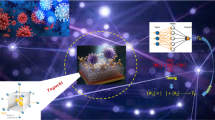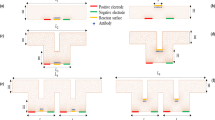Abstract
Optimizing the performance parameters, including the detection time, of microfluidic biosensors is crucial for enhancing their efficiency and accuracy. In this study, the detection time \(({T}_{R})\) was optimized by considering control parameters, such as the width of the annular reaction surface (\(\delta R\)), the applied voltage (\({V}_{\mathrm{rms}}\)), the inlet concentration (\({C}_{0}\)), the inlet average velocity (\({U}_{\mathrm{ave}}\)), and the presence of an obstacle. Taguchi’s method was employed to design an L8(25) orthogonal network, enabling optimal parameter settings. The performance parameters were optimized using the signal-to-noise (S/N) ratio curve, and numerical predictive models were developed using multiple linear regression (MLR), quadratic regression, and multi-layer perceptron artificial neural network (MLP-ANN). The theoretical analysis resulted in optimized design parameters, with \(\delta R=5\mu m\), \({V}_{\mathrm{rms}}=5V\), \({C}_{0}=10\mathrm{pmol}/{\mathrm{m}}^{3}\), \({U}_{\mathrm{ave}}=0.5\mathrm{mm}/\mathrm{s}\), and the presence of an obstacle, leading to a minimum response time of 10325 s (2.87 h). Among the key parameters, \({U}_{\mathrm{ave}}\) had the highest contribution (62%) in reducing the response time, while C0 had the lowest contribution (0.1%). The MLP-ANN model exhibited high prediction performance for the response time of the new microfluidic biosensor design, as demonstrated by MAPE, RMSE, VAF, and R2 values. Overall, this study underscores the significance of optimizing performance parameters, particularly the detection time, in microfluidic biosensors. It utilizes Taguchi's method, develops numerical predictive models, and provides optimized parameter settings. The results highlight the substantial impact of \({U}_{\mathrm{ave}}\) and the minimal contribution of C0 in reducing the response time. Additionally, the MLP-ANN model demonstrates outstanding prediction accuracy for the response time of the new microfluidic biosensor design.
















Similar content being viewed by others
References
Abedini-Nassab R, Pouryosef Miandoab M, Şaşmaz M (2021) Microfluidic synthesis, control, and sensing of magnetic nanoparticles: a review. Micromachines 12(7):768
Antony J (2006) Taguchi or classical design of experiments: a perspective from a practitioner. Sens Rev 26(3):227–230
Choi JR (2020) Development of point-of-care biosensors for COVID-19. Front Chem 8:517
Daneshvar N, Khataee A, Rasoulifard M, Pourhassan M (2007) Biodegradation of dye solution containing malachite green: optimization of effective parameters using Taguchi method. J Hazard Mater 143(1–2):214–219
Droesbeke J-J, Fine J, Saporta G (1997) Plans d'expériences: applications à l'entreprise. Editions technip
Echouchene F, Al-Shahrani T, Belmabrouk H (2020) Simulation of the slip velocity effect in an AC electrothermal micropump. Micromachines 11(9):825
Echouchene F, Al-shahrani T, Belmabrouk H (2021a) Enhancement of heterogeneous microfluidic immunosensors using new sensing area shape with electrothermal effect. Appl Sci 11(10):4566
Echouchene F, Al-Shahrani T, Belmabrouk H (2021b) Analysis of temperature-Jump boundary conditions on heat Transfer for heterogeneous microfluidic immunosensors. Sensors 21(10):3502
Gervais L, De Rooij N, Delamarche E (2011) Microfluidic chips for point-of-care immunodiagnostics. Adv Mater 23(24):H151–H176
Ivakhnenko A (1970) Heuristic self-organization in problems of engineering cybernetics. Automatica 6(2):207–219
Jamil M, Ng E (2013) Statistical modeling of electrode based thermal therapy with Taguchi based multiple regression. Int J Therm Sci 71:283–291
Janmanee P, Muttamara A (2011) Optimization of electrical discharge machining of composite 90WC-10Co based on Taguchi approach. Eur J Sci Res 64(3):426–436
Kaziz S, Saad Y, Bouzid M, Selmi M, Belmabrouk H (2021) Enhancement of COVID-19 detection time by means of electrothermal force. Microfluid Nanofluid 25:1–12
Kaziz S, Saad Y, Gazzah MH, Belmabrouk H (2022) 3D simulation of microfluidic biosensor for SARS-CoV-2 S protein binding kinetics using new reaction surface design. Eur Phys J plus 137(2):241
Kaziz S, Romdhane IB, Echouchene F, Gazzah MH (2023) Numerical simulation and optimization of AC electrothermal microfluidic biosensor for COVID-19 detection through Taguchi method and artificial network. Eur Phys J plus 138(1):96
Kaziz S (2023) Enhancement of SARS-CoV-2 Detection Time for Integrated Flow Confinement Microfluidic Biosenso
Ke J, Liu X (2008) Empirical analysis of optimal hidden neurons in neural network modeling for stock prediction. In: 2008 IEEE Pacific-Asia Workshop on Computational Intelligence and Industrial Application, 2: 828–832.
Li J, Lillehoj PB (2021) Microfluidic magneto immunosensor for rapid, high sensitivity measurements of SARS-CoV-2 nucleocapsid protein in serum. ACS Sensors 6(3):1270–1278
Lynn NS Jr et al (2014) Biosensing enhancement using passive mixing structures for microarray-based sensors. Biosens Bioelectron 54:506–514
Montgomery DC, Peck EA, Vining GG (2021) Introduction to linear regression analysis. John Wiley & Sons
Morozov VN, Groves S, Turell MJ, Bailey C (2007) Three minutes-long electrophoretically assisted zeptomolar microfluidic immunoassay with magnetic-beads detection. J Am Chem Soc 129(42):12628–12629
Noura Z et al (2022) Wearable healthcare monitoring based on a microfluidic electrochemical integrated device for sensing glucose in natural sweat. Sensors 22(22):8971
Pachucki CT, Khurshid MA, Nawrocki J (2004) Utility of reverse transcriptase PCR for rapid diagnosis of influenza a virus infection and detection of amantadine-resistant influenza a virus isolates. J Clin Microbiol 42(6):2796–2798
Pedhazur EJ, Kerlinger FN (1982) Multiple regression in behavioral research. Holt, Rinehart, and Winston
Qi C et al (2006) Investigation of interaction between two neutralizing monoclonal antibodies and SARS virus using biosensor based on imaging ellipsometry. Biomed Microdevice 8(3):247–253
Romdhane IB, Jemmali A, Kaziz S, Echouchene F, Alshahrani T, Belmabrouk H (2023) Taguchi method: artificial neural network approach for the optimization of high-efficiency microfluidic biosensor for COVID-19. Eur Phys J plus 138(4):359
Sackmann EK, Fulton AL, Beebe DJ (2014) The present and future role of microfluidics in biomedical research. Nature 507(7491):181–189
Selmi M, Echouchene F, Gazzah MH, Belmabrouk H (2015) Flow confinement enhancement of heterogeneous immunoassays in microfluidics. IEEE Sens J 15(12):7321–7328
Selmi M, Khemiri R, Echouchene F, Belmabrouk H (2016a) Electrothermal effect on the immunoassay in a microchannel of a biosensor with asymmetrical interdigitated electrodes. Appl Therm Eng 105:77–84
Selmi M, Khemiri R, Echouchene F, Belmabrouk H (2016b) Enhancement of the analyte mass transport in a microfluidic biosensor by deformation of fluid flow and electrothermal force. J Manuf Sci Eng 10(1115/1):4033484
Selmi M, Echouchene F, Belmabrouk H (2016c) Analysis of microfluidic biosensor efficiency using a cylindrical obstacle. Sens Lett 14(1):26–31
Shahbazi F, Jabbari M, Esfahani MN, Keshmiri A (2021) A computational simulation platform for designing real-time monitoring systems with application to COVID-19. Biosens Bioelectron 171:112716
Sigurdson M, Wang D, Meinhart CD (2005) Electrothermal stirring for heterogeneous immunoassays. Lab Chip 5(12):1366–1373
Tabrizi SS, Sancar N (2017) Prediction of body mass index: a comparative study of multiple linear regression, ANN and ANFIS models. Procedia Computer Sci 120:394–401
Tang R et al (2017) A fully disposable and integrated paper-based device for nucleic acid extraction, amplification and detection. Lab Chip 17(7):1270–1279
Vemula SV, Zhao J, Liu J, Wang X, Biswas S, Hewlett I (2016) Current approaches for diagnosis of influenza virus infections in humans. Viruses 8(4):96
Venkateswarlu G, Davidson M, Tagore G (2010) Influence of process parameters on the cup drawing of aluminium 7075 sheet. Int J Eng Sci Technol. https://doi.org/10.4314/ijest.v2i11.64553
Zhifeng J, Feng A, Li T (2020) Consistency analysis of COVID-19 nucleic acid tests and the changes of lung CT. J Clin Virol 127:104359
Zouaghi N et al (2023) Miniaturized rapid electrochemical immunosensor based on screen printed carbon electrodes for mycobacterium tuberculosis detection. Biosensors 13(6):589
Author information
Authors and Affiliations
Contributions
Sameh Kaziz designed, prepared the original draft and wrote the manuscript. Asma Jemmali organized and checked the data and Fraj Echouchene supervised all the work.
Corresponding author
Ethics declarations
Conflict of interest
The authors declare that they have no known competing financial interests or personal relationships that could have appeared to influence the work reported in this paper.
Additional information
Publisher's Note
Springer Nature remains neutral with regard to jurisdictional claims in published maps and institutional affiliations.
Rights and permissions
Springer Nature or its licensor (e.g. a society or other partner) holds exclusive rights to this article under a publishing agreement with the author(s) or other rightsholder(s); author self-archiving of the accepted manuscript version of this article is solely governed by the terms of such publishing agreement and applicable law.
About this article
Cite this article
Kaziz, S., Jemmali, A. & Echouchene, F. Optimization of annular microfluidic biosensor enhanced by active and passive effects using Taguchi’s method coupled with multi-layer perceptron neural networks (MLP-NN) models. Microfluid Nanofluid 27, 60 (2023). https://doi.org/10.1007/s10404-023-02670-3
Received:
Accepted:
Published:
DOI: https://doi.org/10.1007/s10404-023-02670-3




